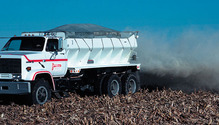
It doesn't matter where you hang your hat or pay taxes, alfalfa will not grow or be productive unless soil pH is 6.5 or higher (preferably 6.8 to 7.0). According to the Alfalfa Management Guide (North Central Region Extension Publication NCR 547), "Liming is the single most important fertility concern for establishing and maintaining high-yielding, high-quality alfalfa stands."
Fall is the time of year for soil testing, and once those results are known, it's also a great time to get needed lime applied and incorporated into the soil.
The primary reason alfalfa is a relatively high soil pH crop is not so much because of the plant, but rather for the Rhizobium bacteria that fix nitrogen for the crop. In acidic soil conditions, bacterial activity and nitrogen fixation become compromised and alfalfa productivity is severely impacted. Effectively, the crop suffers from a bad case of nitrogen deficiency.
Ed Rayburn, West Virginia University extension forage agronomist, also notes that at low soil pH the solubility of aluminum and manganese increases. These minerals are toxic to plants and aluminum ties up phosphorus and makes it less available for root uptake.
The effectiveness of agricultural lime for raising pH hinges on two primary factors: purity and fineness of grind. The purity of lime will determine how much is needed to raise soils to the desired pH. Fineness is a function of how fast it will occur; course lime sources being slower than fine ones. Most state extension services have information on how to determine the neutralizing power of a particular lime source.
It's most cost effective to apply lime at least two years before establishing alfalfa. The process of changing soil pH takes time. Soils differ in their native pH. Some limestone-based soils maintain a pH near 7.0, other soils hover at something below 6.0. In the latter case, it may not be economically feasible to bring soil pH higher than 6.5. Again, check your state's extension recommendations.
Sometimes a low soil pH problem isn't discovered until after the alfalfa is established. This is a situation that requires a shift into rescue mode. Though topdressing lime on alfalfa is not typically recommended, few other options remain if the alfalfa is already established. Don't expect full productivity, but the alfalfa will generally respond if a fine, fast-acting lime source is topdressed. For permanent pastures, topdressing is also an option.
Though there are many management factors to be considered for alfalfa, none of them will overcome a low soil pH. North, south, east or west, if you grow alfalfa or want to grow alfalfa, it all starts with a soil test to determine soil pH.

